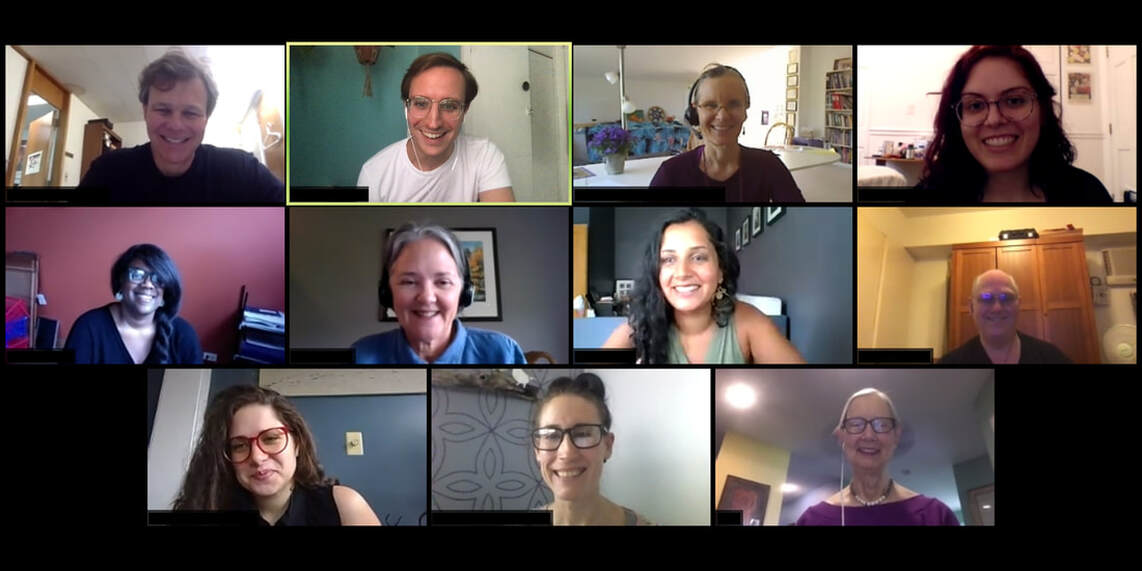|
The Technology of Participation (ToP) methods were distilled from decades of experience facilitating meaningful, transformative experiences in community. The methods have been applied throughout the world, in cities, towns, and villages. They have been used at every scale from the United Nations and Fortune 500 companies down to staff meetings and family gatherings. For most of its history, ToP has thrived in-person, face-to-face. While facilitators have taken ToP methods to new frontiers of technology, the core of ToP training remains predicated on meaningful face-to-face interaction. Courses are designed to be format neutral, meaning it should be trained as equally applicable to whatever tool a facilitator wants to use. Since a lot of virtual skill-building focuses on the technical aspects of specific platforms, such as Zoom, Mural, or Adobe Connect, moving ToP training online is not a simple translation.
When the global pandemic reached the United States, we wanted to hold the tension between retaining the quality of ToP training and meeting the urgent need for virtual facilitation. Many ToP Trainers rose to the occasion organically, offering a wide variety of resources from virtual facilitation bootcamps to self-paced online learning and platform-specific tutorials to technical and design support tailored to clients. ICA responded to the lead taken by ToP Trainers by compiling and promoting their virtual offerings to ToP course grads nationwide. While the resources offered are not formal ToP courses, they represent the spirit of the methods and the innovation of the Trainers who deliver that training year-round. Beyond simply promoting the offerings that already exist, ToP Trainers formed three new cohorts with aims to: support peer-learning around technical skills for virtual facilitation, share approaches that work and bolster the development of new virtual course offerings, and develop a model for virtually training the foundation course, ToP Facilitation Methods (TFM). ICA has a history of sharing approaches that work. Beginning in the summer of 1965, ICA staff and colleagues gathered in Chicago each July to build themselves as a global movement. Beginning in 1970, these events were called Global Research Assemblies, and provided a way for a broad cross section of people to help shape the focus, methods, and spirit of ICA and its network of colleagues. In this new virtual world, the Global Research Assembly model is resurfacing anew, accelerated and strengthened by digital connectivity. The most recent Sojourn hosted by the ICA Social Research Center was even described as a “Virtual Global Research Assembly,” as participants from around the world came together to process archival material that has been moved online in recent years. The urgent need for effective virtual facilitation opens the door to a parallel movement for the national network of ToP Trainers, who share methods but are geographically dispersed and tend to work in small groups known as “families.” Many are women-owned small businesses that apply ToP methods to a wide variety of sectors and issues, from federal agencies to grassroots networks and public health to organizational development and beyond. As each Trainer innovates and experiments, the methods grow and expand. The three learning cohorts that have already been created have the potential to become a virtual facilitation research assembly that not only strengthens the tech savvy of individual Trainers, but could led to the creation of new courses exclusive to the virtual world. ToP consultant Seva Gandhi and ICA staff members Samantha Sainsbury and Caitlin Sarro worked together to create a virtual offering from ICA, a two-part training called Shift Happens: Design Principles for a Virtual World. Marketed to facilitators, educators, and community leaders, the Shift Happens pilot combined the ideas of economist and philosopher Kenneth Boulding with a set of design principles for effective group facilitation. Boulding’s classic text, The Image, is distilled into the theory known as image shift, which says that everyone operates out of images of the world that guide their behavior and can be changed by effective messaging. Participants learned how to apply image shift through a session design tool that allows them to navigate the values of the group to deliver effective messages, even in a virtual space. A second offering of the course is expected to be announced soon. Comments are closed.
|
|
4750 N Sheridan Rd, Chicago, IL 60640
773 769 6363 x 335 |
Copyright 2022. The Institute of Cultural Affairs. All rights reserved.

